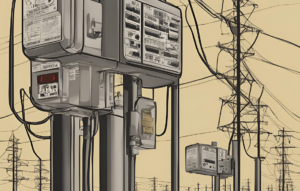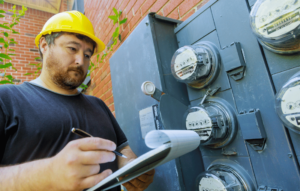As our world becomes more connected and reliant on technology, devices like smart meters have become part of our everyday lives. These digital energy meters are used for their efficiency and relative ease of use, automatically transmitting energy usage data to utility companies. However, with these advancements come concerns, particularly about the electromagnetic fields (EMFs) emitted by smart meters.
Some argue that this exposure represents a growing environmental and health threat, while others dismiss the fears as paranoia. So, are smart meters truly dangerous, or are these concerns overblown? Let’s explore both sides of the debate to find out if it’s worth taking precautions in your home.
What Are Smart Meters and Why Do They Matter?
Smart meters were introduced as a technological upgrade to traditional analog meters, providing real-time data on energy consumption without the need for manual readings. By transmitting data wirelessly, utility companies can efficiently manage energy distribution and offer insights into peak usage times. These benefits seem obvious, but the shift from analog to digital meters has sparked a conversation around the hidden cost – continuous exposure to EMFs.
Traditional analog meters functioned passively, registering energy consumption without emitting any wireless signals. In contrast, smart meters constantly communicate with utility companies, generating a new source of EMF exposure – significantly adding to the sea of radiation that we are exposed to on a daily basis. This has led to growing concerns among health-conscious individuals and environmentalists alike.
EMFs – A New Reality of Our Tech-Driven World
Electromagnetic fields, or EMFs, are an increasingly common part of our tech-driven lives, emitted by everything from cell phones to Wi-Fi routers. These low-level, non-ionizing radiation waves are considered relatively harmless by many standards. However, the cumulative effects of long-term exposure to various EMF sources, including smart meters, remain a subject of growing concern.
Smart meters, unlike many other household devices, operate 24/7, continuously sending wireless signals. This constant exposure, especially when smart meters are installed in densely populated areas or clustered in apartment buildings, contributes to an invisible yet persistent increase in ambient EMFs in our living spaces. While the EMFs emitted by smart meters are typically low, the concern revolves around the question: Does this continuous exposure, on top of the EMFs from all our other devices, create a problem?
The Health Debate
Research into the health effects of EMFs remains inconclusive, but some studies suggest that prolonged exposure to EMFs tends to lead to oxidative stress in the body, potentially contributing to conditions such as chronic fatigue, sleep disruption, and in more extreme cases, neurological disorders. There is also some evidence that constant EMF exposure may disrupt circadian rhythms and impact hormonal balance.
and in more extreme cases, neurological disorders. There is also some evidence that constant EMF exposure may disrupt circadian rhythms and impact hormonal balance.
Critics of smart meters argue that this continuous exposure, even at low levels, adds up over time, potentially increasing the risk of health problems down the road. On the other hand, public health organizations and utility companies maintain that the levels of radiation emitted by smart meters are far below the limits considered harmful by safety standards.
What makes the debate particularly complex is the nature of EMF exposure itself – it’s invisible, and intangible, and its effects are typically sub-perceptual, often surfacing only after long-term exposure. The real question isn’t necessarily whether smart meters alone are a threat, but whether the cumulative exposure from multiple EMF sources in modern life tips the scale toward greater risk.
Exploring the Counterarguments
Skeptics of the EMF-smart meter connection often cite the fact that the levels of radiation emitted by these devices are well within the safety limits established by regulatory agencies like the FCC. They argue that the health concerns surrounding smart meters are based on fear and misinformation rather than concrete scientific evidence.
However, it’s increasingly important that we acknowledge many of these safety standards were established decades ago, long before the explosion of wireless technology that now saturates our lives. The question of whether these old standards are still relevant in a world of smartphones, Wi-Fi, and now smart meters is worth considering. And for those who are particularly sensitive to EMFs, known as Electromagnetic Hypersensitivity (EHS), even low levels of radiation can trigger uncomfortable symptoms such as headaches, fatigue, and dizziness.
While it’s clear that the jury is still out on the long-term effects of EMF exposure, the growing awareness around the issue suggests it’s not a topic that can be easily dismissed as paranoia.
Are Animals at Risk Too?
The impact of EMF exposure isn’t limited to human health. There is growing concern that EMFs may be affecting animals and wildlife, particularly species that rely on

electromagnetic fields for navigation, such as birds and bees. Studies suggest that EMF exposure may interfere with these animals’ natural behavior, potentially contributing to disruptions in migration patterns, reproduction, and survival.
The rapid proliferation of EMF-emitting devices like smart meters could exacerbate these effects, creating ecological imbalances that might not be immediately apparent but could have long-term consequences. While more research is needed to fully understand how EMFs affect wildlife, the potential risks are worth paying attention to, especially when it comes to protecting biodiversity.
Practical Steps and Precautions Without Panic
Given the ongoing debate and the uncertainty surrounding the long-term effects of EMF exposure, what can you do if you’re concerned about smart meters in your home?
- Request a Non-Wireless Meter: In some regions, it is still possible to opt
 out of smart meters and request the installation of a traditional analog meter, which does not emit EMFs. While not always available, it’s worth checking with your utility company if this option is important to you.
out of smart meters and request the installation of a traditional analog meter, which does not emit EMFs. While not always available, it’s worth checking with your utility company if this option is important to you. - Use EMF-Protection Technology: If replacing your smart meter isn’t an option, consider using EMF-protection technology to protect your home. Companies like Aires Tech offer innovative solutions designed to diffract and mitigate EMF exposure. These products can help shield your home from the constant stream of EMFs emitted by smart meters and other wireless devices, providing peace of mind without the need for drastic measures.

Save 25% on all Aires Tech Lifetune products with code “CLP” - Reduce EMF Exposure in the Home: Simple steps like turning off Wi-Fi routers at night, using wired connections where possible, and reducing your use of other wireless devices can all help lower overall EMF exposure. These small actions, combined with protective measures, can go a long way in creating a healthier home environment.
Closing Thoughts
So, are smart meters a mortal threat, or is the hype just paranoia? The truth likely lies somewhere in the middle. While there is not yet definitive proof that the EMFs emitted by smart meters specifically pose an immediate health risk, the growing body of research on the cumulative effects of EMF exposure suggests that caution is certainly warranted. Taking reasonable steps to reduce your exposure, whether by opting for an analog meter or using EMF-harmonizing technology like that offered by Aires Tech, is a sensible approach.
certainly warranted. Taking reasonable steps to reduce your exposure, whether by opting for an analog meter or using EMF-harmonizing technology like that offered by Aires Tech, is a sensible approach.
Ultimately, it’s up to each individual to decide how much risk they are willing to accept in the face of evolving technology. In the meantime, staying informed and taking proactive measures to protect yourself and your home is never a bad idea.’


 out of smart meters and request the installation of a traditional analog meter, which does not emit EMFs. While not always available, it’s worth checking with your utility company if this option is important to you.
out of smart meters and request the installation of a traditional analog meter, which does not emit EMFs. While not always available, it’s worth checking with your utility company if this option is important to you.






